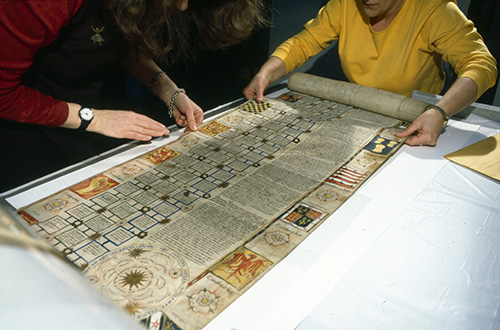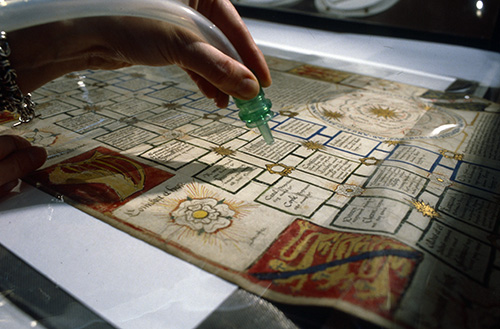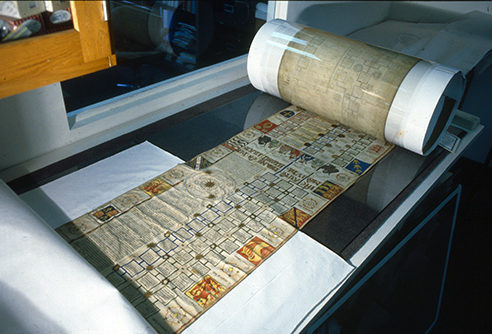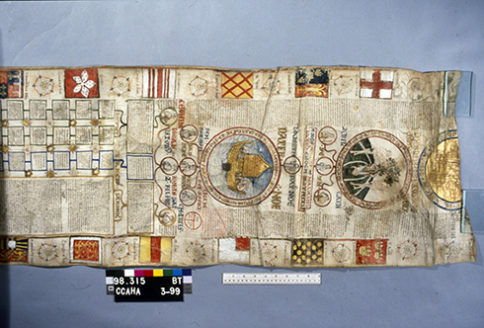
EDWARD IV GENEALOGY ROLLS
As the Wars of the Roses raged in the 15th century, establishing one’s family claim to the throne of England as the rightful one was an urgent priority for the Yorkists and Lancastrians. This battle of legitimacy was waged not only with swords and crossbows, but with ink and vellum.
THE AMERICAN BRANCH & THE EDWARD IV ROLLS
The American Branch has played a significant role in the conservation and enhanced accessibility of these important historical artifacts. Through our Conservation Fund and the generous donations of members, we were able to support preservation work on copies of two genealogies of Edward IV: one held by The Free Library of Philadelphia and the other by the University of Pennsylvania.
Read about them below.
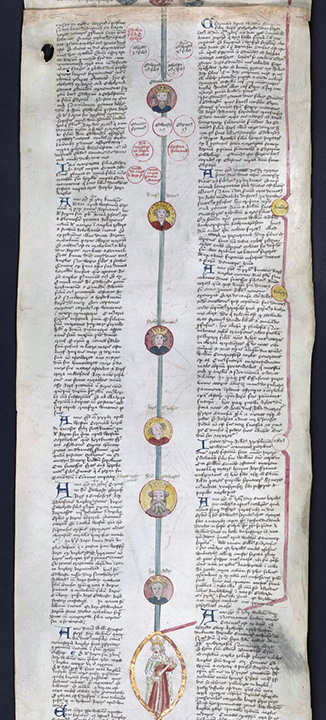
MS Roll 1066
University of Pennsylvania Libraries
At the 2009 Annual General Meeting, the Board presented a request for funding of an online edition of the University of Pennsylvania’s recently-acquired Edward IV Roll. The library planned not only to digitize the Roll in high-resolution image format, but also to provide a complete transcription of the text, identification of the illustrations, and a searchable index of names.
“Historical artifacts can be scarce; examining them can be difficult; understanding them even harder; but the Society has opened a kingdom for all to explore” – Nancy Shawcross, UPenn Curator of Manuscripts
This ambitious undertaking was supported by a gift of $2500 from the Branch treasury, plus an additional $750 in individual members’ donations.
Work was completed in 2012, and an article about the project appeared in the December 2012 edition of the Ricardian Register.
In 2021, Special Collections librarians and students at Penn imported the scanned images of MS 1066 into Digital Mappa software. This tool enabled the team to link files of the roll’s transcribed text directly to the images, allowing for an immersive and interactive user experience.
The Free Library of Philadelphia
MS Lewis E201
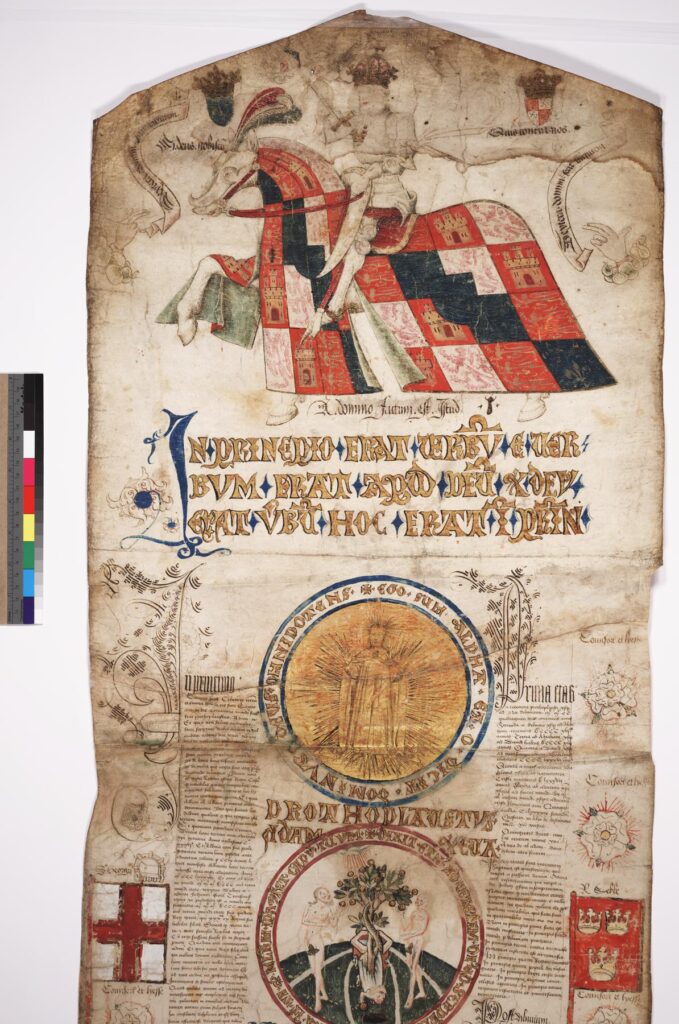
The Free Library’s roll MS Lewis E201 is thought to have been commissioned for Edward IV to celebrate his accession. It traces the descent of Edward from the Biblical Adam through the historic kings of England, and also incorporates legendary kings such as Arthur, drawing upon the works of medieval historians such as Geoffrey of Monmouth, Matthew Paris, and others. More than fifteen feet long and lavishly illustrated, it depicts Adam and Eve, a world map, portraits of past kings, Biblical scenes, and many illuminated initials.
It was created to justify Edward IV’s accession to the throne of England by right of birth and to challenge the right of his predecessor, and is very much a work of fifteenth-century propaganda.
“This is the only English roll known that commences with a portrait of a ruling king, and the portrait itself is exceptional in depicting Edward in full armor on a high-stepping horse, his sword raised in an aggressive statement of his de facto power.” –Kathleen Scott
1998 Conservation
The Free Library’s Edward IV Roll underwent extensive conservation work prior to its 2001 exhibition in “Leaves of Gold: Treasures of Manuscript Illumination from Philadelphia Collections” at the the Philadelphia Museum of Art. Conservation was supported by a $5,000 gift from the American Branch in 1998 after a group of American Branch members visited and viewed the Roll in 1993. An article about the visit was published in the Fall 1993 edition of the Ricardian Register, further increasing awareness of the Roll.
Scroll down to read more about the conservation process.
2023-2024 Digital Mapping Project
In 2023, the American Branch donated funds to recruit and support a team of U. Penn PhD students, overseen by Prof. Emily Steiner, to transcribe and translate the roll in its entirety. In partnership with volunteers from the Branch, the group is working to create a fully interactive, Digital Mappa edition of Lewis E201 similar to that of MS 1066, above, but that will include transcribed and translated text, as well as extensive annotations and background information about its many heraldric and symbolic images.
This work is still in progress. The project should go live in late 2024, and will be linked here.
THE CONSERVATION PROCESS
by Laura Blanchard
For an object more than 500 years old, the Edward IV Roll was in surprisingly good condition.
Still, age and handling had begun to take its toll.
The portrait of Edward IV at the head of the roll was dirty and worn. Surface dirt had obscured many of the illustrations. There were minor tears to be repaired and wrinkles to be removed.
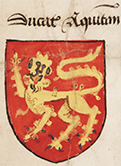
More alarmingly, the surface media (pigments, gold leaf, ink) were beginning to detach from the vellum, loosening and flaking off as the manuscript was unrolled and re-rolled. Finally, because it had been rolled tightly for many years, a section of the manuscript with an important gold-leaf over ink drawing had become seriously distorted and needed to be flattened without damaging the artwork.
The Conservation Center for Art and Historic Artifacts designed an ingenious assembly-line process to restore the long and cumbersome roll.
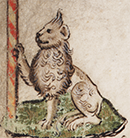
First the entire roll was cleaned of surface dirt. Then, working in sections, the conservators humidified the manuscript using GoreTex fabric to relax the creased and cockled (or wrinkled) areas. The section was placed on a special table that applied suction through the underside of the manuscript. The conservators quickly smoothed the creases through layers of polyester film. The surface media was consolidated using a dilute solution of gelatin in deionized water, delivered in an ultrasonic mist. Each section was dried on the suction table, then flattened between layers of blotting papers under weight. Once finished, the section is virtually wrinkle-free.
Finally, the conservators constructed a new housing of a much larger diameter to minimize the stress on the manuscript when it was rolled and unrolled.
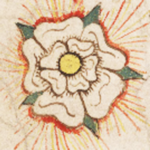
Aside from the Free Library of Philadelphia and Univ. of Penn, here is a selection of other places to learn about and view genealogical rolls from the late medieval period.

